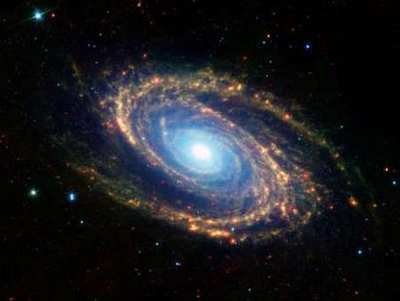Epsilon Eridani May Also Hold Additional Planets
New observations from NASA's Spitzer Space Telescope indicate
that the nearest planetary system to our own has two asteroid
belts. Our own solar system has just one.

The star at the center of the nearby system, called Epsilon
Eridani, is a younger, slightly cooler and fainter version of the
sun. Previously, astronomers had uncovered evidence for two
possible planets in the system, and for a broad, outer ring of icy
comets similar to our own Kuiper Belt.
Now, Spitzer has discovered that the system also has dual
asteroid belts. One sits at approximately the same position as the
one in our solar system. The second, denser belt, most likely also
populated by asteroids, lies between the first belt and the comet
ring. The presence of the asteroid belts implies additional planets
in the Epsilon Eridani system.
"This system probably looks a lot like ours did when life first
took root on Earth," said Dana Backman, an astronomer at the SETI
Institute, in Mountain View, CA and outreach director for NASA's
Sofia mission. "The main difference we know of so far is that it
has an additional ring of leftover planet construction material."
Backman is lead author of a paper about the findings to appear
January 10 in the Astrophysical Journal.
 Asteroid belts are rocky and
metallic debris left over from the early stages of planet
formation. Their presence around other stars signals that rocky
planets like Earth could be orbiting in the system's inner regions,
with massive gas planets circling near the belts' rims. In our own
solar system, for example, there is evidence that Jupiter, which
lies just beyond our asteroid belt, caused the asteroid belt to
form long ago by stirring up material that would have otherwise
coalesced into a planet. Nowadays, Jupiter helps keep our asteroid
belt confined to a ring.
Asteroid belts are rocky and
metallic debris left over from the early stages of planet
formation. Their presence around other stars signals that rocky
planets like Earth could be orbiting in the system's inner regions,
with massive gas planets circling near the belts' rims. In our own
solar system, for example, there is evidence that Jupiter, which
lies just beyond our asteroid belt, caused the asteroid belt to
form long ago by stirring up material that would have otherwise
coalesced into a planet. Nowadays, Jupiter helps keep our asteroid
belt confined to a ring.
Astronomers have detected stars with signs of multiple belts of
material before, but Epsilon Eridani is closer to Earth and more
like our sun overall. It is 10 light-years away, slightly less
massive than the sun, and roughly 800 million years old, or
one-fifth the age of the sun.
Because the star is so close and similar to the sun, it is a
popular locale in science fiction. The television series Star Trek
and Babylon 5 referenced Epsilon Eridani, and it has been featured
in novels by Issac Asimov and Frank Herbert, among others.
The popular star was also one of the first to be searched for
signs of advanced alien civilizations using radio telescopes in
1960. At that time, astronomers did not know of the star's young
age.
Spitzer observed Epsilon Eridani with both of its infrared
cameras and its infrared spectrometer. When asteroid and comets
collide or evaporate, they release tiny particles of dust that give
off heat, which Spitzer can see. "Because the system is so close to
us, Spitzer can really pick out details in the dust, giving us a
good look at the system's architecture," said co-author Karl
Stapelfeldt of NASA's Jet Propulsion Laboratory, Pasadena, CA.
The asteroid belts detected by Spitzer orbit at distances of
approximately 3 and 20 astronomical units from the star (an
astronomical unit is the average distance between Earth and the
sun). For reference, our own asteroid belt lies at about 3
astronomical units from the sun, and Uranus is roughly 19
astronomical units away.
One of the two possible planets previously identified around
Epsilon Eridani, called Epsilon Eridani, was discovered in 2000.
The planet is thought to orbit at an average distance of 3.4
astronomical units from the star -- just outside the innermost
asteroid belt identified by Spitzer. This is the first time that an
asteroid belt and a planet beyond our solar system have been found
in a similar arrangement as our asteroid belt and Jupiter.
Some researchers had reported that Epsilon Eridani b orbits in
an exaggerated ellipse ranging between 1 and 5 astronomical units,
but this means the planet would cross, and quickly disrupt, the
newfound asteroid belt. Instead, Backman and colleagues argue that
this planet must have a more circular orbit that keeps it just
outside the belt.
The other candidate planet was first proposed in 1998 to explain
lumpiness observed in the star's outer comet ring. It is thought to
lie near the inner edge of the ring, which orbits between 35 and 90
astronomical units from Epsilon Eridani.

The intermediate belt detected by Spitzer suggests that a third
planet could be responsible for creating and shepherding its
material. This planet would orbit at approximately 20 astronomical
units and lie between the other two planets. "Detailed studies of
the dust belts in other planetary systems are telling us a great
deal about their complex structure," said Michael Werner, co-author
of the study and project scientist for Spitzer at JPL. "It seems
that no two planetary systems are alike."
 ANN's Daily Aero-Linx (04.15.24)
ANN's Daily Aero-Linx (04.15.24) Classic Aero-TV: 'No Other Options' -- The Israeli Air Force's Danny Shapira
Classic Aero-TV: 'No Other Options' -- The Israeli Air Force's Danny Shapira Aero-News: Quote of the Day (04.15.24)
Aero-News: Quote of the Day (04.15.24) Airborne 04.16.24: RV Update, Affordable Flying Expo, Diamond Lil
Airborne 04.16.24: RV Update, Affordable Flying Expo, Diamond Lil ANN's Daily Aero-Term (04.16.24): Chart Supplement US
ANN's Daily Aero-Term (04.16.24): Chart Supplement US





